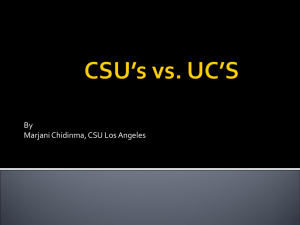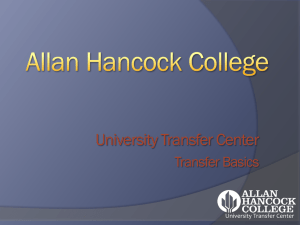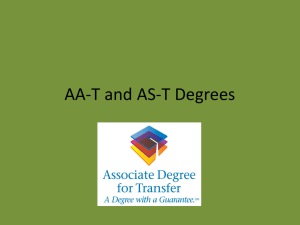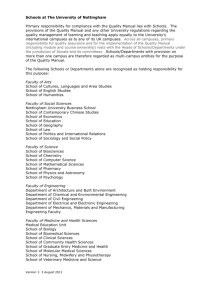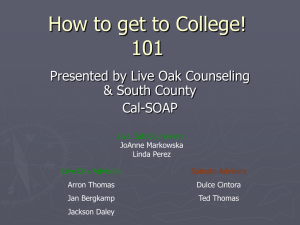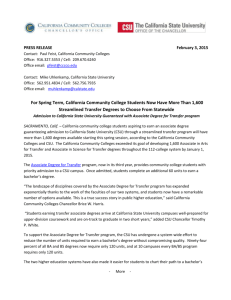The Road Never Travelled - California State University, Long Beach
advertisement
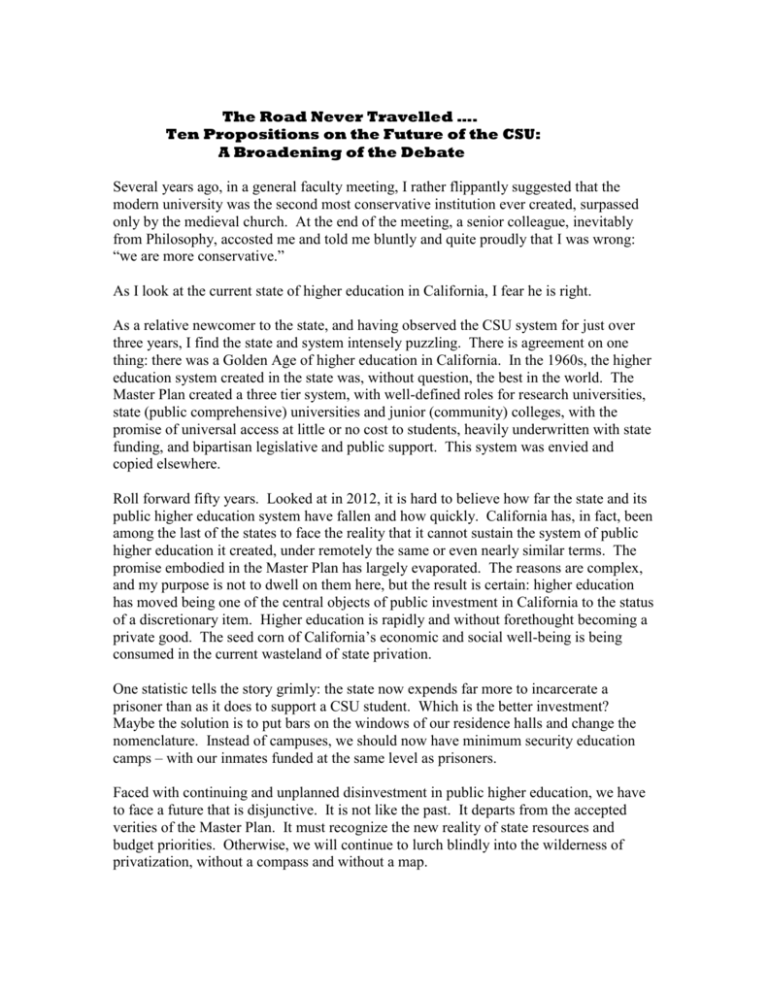
The Road Never Travelled …. Ten Propositions on the Future of the CSU: A Broadening of the Debate Several years ago, in a general faculty meeting, I rather flippantly suggested that the modern university was the second most conservative institution ever created, surpassed only by the medieval church. At the end of the meeting, a senior colleague, inevitably from Philosophy, accosted me and told me bluntly and quite proudly that I was wrong: “we are more conservative.” As I look at the current state of higher education in California, I fear he is right. As a relative newcomer to the state, and having observed the CSU system for just over three years, I find the state and system intensely puzzling. There is agreement on one thing: there was a Golden Age of higher education in California. In the 1960s, the higher education system created in the state was, without question, the best in the world. The Master Plan created a three tier system, with well-defined roles for research universities, state (public comprehensive) universities and junior (community) colleges, with the promise of universal access at little or no cost to students, heavily underwritten with state funding, and bipartisan legislative and public support. This system was envied and copied elsewhere. Roll forward fifty years. Looked at in 2012, it is hard to believe how far the state and its public higher education system have fallen and how quickly. California has, in fact, been among the last of the states to face the reality that it cannot sustain the system of public higher education it created, under remotely the same or even nearly similar terms. The promise embodied in the Master Plan has largely evaporated. The reasons are complex, and my purpose is not to dwell on them here, but the result is certain: higher education has moved being one of the central objects of public investment in California to the status of a discretionary item. Higher education is rapidly and without forethought becoming a private good. The seed corn of California’s economic and social well-being is being consumed in the current wasteland of state privation. One statistic tells the story grimly: the state now expends far more to incarcerate a prisoner than as it does to support a CSU student. Which is the better investment? Maybe the solution is to put bars on the windows of our residence halls and change the nomenclature. Instead of campuses, we should now have minimum security education camps – with our inmates funded at the same level as prisoners. Faced with continuing and unplanned disinvestment in public higher education, we have to face a future that is disjunctive. It is not like the past. It departs from the accepted verities of the Master Plan. It must recognize the new reality of state resources and budget priorities. Otherwise, we will continue to lurch blindly into the wilderness of privatization, without a compass and without a map. ROAD 2 Faced with the new reality and in the absence of any overarching plan, the reaction of the three systems of higher education has been divergent – three different roads taken. The constitutionally autonomous University of California system has largely declared independence, relying on its ability to replace diminished state support with other sources of revenue, increasing the numbers of non-resident and overseas students, enhancing private support through fundraising and leveraging grants and contracts. New genetically modified hybrid corn, high yielding: it requires progressively less state support for sustenance. The community college system has worked over the past year to craft a new blueprint for the system. Advancing Student Success in California Community Colleges provides a stark reminder of how dire things have become in the community college system. They are awash in students – 133,000 of whom could not find even a single course in 2009-10 for lack of space. Not only are they experiencing diminished state investment, their fees are the last bastion of the promise of the Master Plan – the eroded remnant of an ancient landscape – kept to minimal levels to assure access, but access to what? The community college system lacks the resources to provide for their instruction, so student progress towards their educational goals has been slowed to a glacial pace. The community colleges lack the two levers – restricting enrollment and fee increases – which the CSU has been able to pull. It is small wonder then that the transfer of students from the community colleges to the CSU has slowed markedly. Seed corn germinating too slowly to mature: a crop stunted. Alone among the systems, the CSU has failed to muster a convincing long-term response. In the short-run, the CSU system, for the first time in 2010, reduced access by limiting the number of new students. While many colleagues will no doubt disagree, this was the only possible immediate, but limited, political response to a round of draconian budget cuts. The limitation is that it is neither sustainable nor is it sound public policy to deprive qualified students of the opportunity they deserve. As with the UC, it has raised tuition sharply, potentially pricing some students out of higher education entirely. Seed corn, never allowed to germinate. We are a system in crisis. We cannot assume that any of the old principles apply any longer to the CSU. We need to invent our future. We need to chart a course through the wilderness and find a viable road to travel. So how do we do it? We need to start with five basic principles: Any plan needs to incorporate: access, affordability, accountability, and quality, all underwritten with consistent public investment. We need to retain a commitment to access for all qualified students to a high quality CSU education. In partnership with the state government, we need to reassert that ROAD 3 a publicly supported opportunity for a CSU education will remain within reach for all qualified students. On the part of the CSU system, we must reaffirm that we are accountable for those investments and make them smarter and better targeted, even as we aggressively seek new sources of revenue. We need to demonstrate program quality and value and be able recruit and retain the people -faculty and staff- who make that happen. On the part of the state, there must be a reinvigoration of its commitment to investment in public higher education. As a recent transplant, I have discovered that the state loves propositions so much that it is governed by them. So here are ten about the CSU system. Prop. 1: The Master Plan is Dead … Long Live the Plan. The state has a vested interest in maintaining the fiction that the Master Plan is alive. The reason is simple. If the Plan is alive, there is no need to rethink what we, as a state, are doing, no need to question any assumptions or change the way in which we invest State funds. Once or twice a year, the Master Plan makes its ritual appearance in Sacramento – the shroud of Sacramento is paraded through the legislature. It is treated, as sacred relics should be, with a hushed reverence, as its bleached bones are revealed. The Master Plan lives! The state needs to extricate itself from denial and admit that the Master Plan, as originally conceived, is dead and has been dead for a long time. The CSU system, complicit in perpetuating the fiction, needs to do likewise. It must work urgently on a new plan for the CSU system engaging in a fundamental rethinking of the role and mission within higher education in the state and a reappraisal of how we, as a system, do our business. Until that occurs, we will be stuck in a 1960s time warp, with 2012 resources, and we will simply continue to wander aimlessly, deeper into the uncharted wilderness of privation and privatization, doing business as usual (while occasionally saying we aren’t) in an environment altered beyond recognition. Step One: There is a crisis and the current system must be restructured. The Master Plan is dead. Create a new one. Prop. 2: Let’s Talk … Really. While an independent reassessment of the CSU role and mission is long overdue, this should not and cannot take place in isolation. The CSU system, the UC system, and the community college system need to engage in a much broader conversation with the state government. Start with this simple proposition: the state can no longer afford to provide the level of subsidy for public higher education envisaged in the (now dead) Master Plan. This may be denied by some in state government, but the reduction of $700M in state funding over the past three years in the CSU system alone and the prospect of a further $250M ‘trigger cut’ in November eloquently tell a different tale. We need the state to address fundamental and uncomfortable questions: how much higher education can California afford, now and into the foreseeable future? Who and what is the state willing to subsidize? Students or ROAD 4 institutions? How can we achieve a predictable balance between tuition levels, state support and student financial aid to assure some level of access by ability, rather than ability to pay? What does state government expect from each of its public higher education sectors and how might these expectations influence our funding? And is there a need for a re-evaluation of the roles of the three sectors in the wake of the death of the Master Plan? There is also a need for a broader conversation involving higher education and the K-12 system. It is most urgently needed with regard to the articulation points between the sectors. How can we partner with the K-12 system to assure that high school graduates enter the CSU (or the UC) with the skills they need to succeed, thereby reducing the provision for remediation? How can we and the UC work with the community colleges to assure easy and efficient transfer between the two systems? Or between the UC and CSU campuses? Or indeed between sister campuses in the CSU system? All of these demand sustained and substantive conversation within and between the sectors. Step Two: Engage the state in an urgent discussion of the future of higher education in a post-Master Plan era. Engage the other education sectors in a discussion to create a frictionless system of public education. Align the expectations across the K16 system and ease the movement across the sectors. Prop. 3: Let’s Admit … One of the cornerstones of the Master Plan is the promise of access for all qualified students to the UC and CSU systems. For the CSU, the Master Plan envisages that all students in the top one-third of their graduating class are eligible for admission. Is this promise being fulfilled? The answer in the CSU system is unequivocal. A recent report to the Board of Trustees notes that of the 117,000 qualified applicants to the CSU in 2011-12, only 95,000 were admitted. In other words, about twenty per cent of those admissible were turned away by the system last year. No longer can we claim that we remain accessible to all qualified students. This eliminates one of the cornerstones of the Master Plan. We need to rethink the criteria for admission to the CSU. The goal should be simple: ensure that students entering the CSU are adequately prepared for success in higher education. It is tempting to treat this as a K-12 problem, but it is really a joint responsibility. One of the key areas where improvement could be made and made quickly is by setting higher standards for English and Mathematics and adhering to these in the admissions process. The recent Early Start program enacted by the system is a stuttering step in that direction, but is a poor substitute for a more meaningful twelfth grade experience or, indeed, an intensive summer immersion program. The results from Early Start contrast unfavorably with other, more intensive approaches. Less than three per cent of the students advanced one or more levels in Math at CSUSB after their Early ROAD 5 Start experience. By contrast, more than ninety per cent advanced at least one level with our Intensive Math Program (ironically at a lower cost to the student). The longer term solution is to ensure that there is a meaningful twelfth grade experience that allows the student to come into the university prepared. From the perspective of the student, the ability for them to communicate effectively in oral and written form and to have a reasonable level of numeracy provides them with the tools they need to ensure success in a university setting. From the perspective of the State, there is the obvious benefit that the state will no longer pay twice for the same thing: once for the student in high school and again for that same student in the university. From the perspective of the university, there is a substantial cost saving in reducing the amount of remediation provided, permitting the redeployment of those resources and also potentially improving time to degree. The importance of a student coming into the university with the skills needed to embark immediately on university level courses is quite clear. At CSUSB, a student entering with no need for remediation is nearly two and a half times more likely to graduate in six years (53% vs. 23%) than a student requiring the maximum amount of remedial work. Remediation, not surprisingly, lengthens time to degree and only 1% of the students requiring the most extended remedial work graduate in four years from CSUSB, compared to 23% who required none. Step Three: Revise the admission criteria to reflect the fact that we can no longer accommodate the top one third of the graduates. Work with the K-12 system to ensure adequate preparation of students. Phase in new admission standards. Prop. 4: Another Admission … the Blunt Instrument of Impaction. There is an extraordinary labyrinth of practices surrounding admission to a CSU campus. On the face of it, the admission process looks simple. First year students who meet the a-g requirements, and achieve a threshold combination of high school grade point average and SAT or ACT score, combined into an admissions index, are eligible to matriculate at any CSU. (Interestingly, the results on eligibility obtained using the two test scores do not actually align). Transfer students satisfying the four basic skills requirement and having a grade point average of 2.0 are eligible for admission. Theoretically, any student meeting these standards should be eligible for admission to any campus. Of course, this is not actually the case. Some campuses receive larger numbers of applications than they can accommodate, so the process that has been created by the CSU system to deal with the problem is to permit campuses to declare impaction. A declaration of campus impaction simply states that the campus is unable to offer admission to all eligible students. The campus is then permitted to use secondary admission criteria in the selection of new students. The secondary criterion employed at the campus level involves the definition of a local area. This local area is typically, but not invariably, a subset of the service area. Students within the local area must meet the ROAD 6 minimum admissions requirements: those outside would be subject to out of area requirements, varying from one institution to another. It gets even more complex. Campuses can also declare program impaction. The logic for program impaction is identical, except that, in this case, the campus receives more applications than it can accommodate for a particular program. This means that supplemental criteria can be employed and admission standards will be higher for admission to those programs than to the university as a whole. Sixteen CSU campuses are currently impacted for first year admissions and fifteen for upper division transfers. Five campuses (Fullerton, Long Beach, San Diego, San Jose and San Luis Obispo) are impacted for all majors, and even campuses which are not impacted overall may have individual programs that are impacted. There are a total of 50 impacted programs, in addition to the five campuses where all programs are impacted. The result of this elaborate process is a crazy quilt of admissions requirements. Only students applying to one of the eight CSU campuses that have not declared impaction (for first time students) or living within the local area of a particular campus are actually assured of admission, after meeting the threshold standards, except if they happen to apply to an impacted program. Students from outside the local area face differing admissions standards at every campus they apply. Particularly disadvantaged are students who are not part of any campus’ local area, where the minimum requirements would only be applicable to often distant non-impacted campuses. Step Four: Scrap impaction. Allow campuses to set their own admission requirements, overall and/or by program. Prop. 5: Prisoners of Geography… One of the enduring legacies of the Master Plan is the idea of a unique geographical service area for each campus. These are a curious anachronism, made even more so by the widespread declarations of impaction by individual campuses. The logic of the service area was presumably to give admission preference to nearby residents of a campus who meet minimum admission standards. This makes good sense if three conditions are fulfilled. The first, and most obvious, is that by attending a local campus students can live at home and thereby reduce the total cost of attendance. This obviously continues to be true. The second reason why a local service area makes sense is if there are substantial constraints on student mobility. This may have been a quite persuasive argument in 1960, but is much more debatable in the twenty-first century environment. Even in the earlier period, for a significant minority of students in California, there never was a local option available - a simple reflection of geography – they lived too far away from any CSU campus to be allowed the opportunity to commute. Nonetheless, the idea of place-bound student remains deeply ingrained in the system’s mythology. The third and tacit assumption is that a local student would have access to a uniform range of degree programs regardless which campus he or she attended. This has never been true and exposes the rather peculiar double-standard in the ROAD 7 thinking about the local service area. For a student living within a reasonable commuting range of one or more campuses and wishing to embark on a Sociology, Spanish, Biology or English degree at a CSU, there is ubiquitously a local option. Are they actually placebound if they select an available local option or are they expressing an economically rational preference? For students anywhere in the state wishing to study Engineering, Agriculture, Environmental Management, Architecture, Arabic and a host of other majors, unless they live in range of the one or more campuses that offer these options, then perforce they would have to relocate. Here we know that most students selecting those majors have to relocate. What we do not know is how many students who would prefer to take these sporadically available programs are deprived of access to a particular degree simply because they are unable to relocate. How many students are, in fact place-bound today? The prevailing assumption is that they form the great majority (80% of students was a figure airily cited in a recent Academic Council meeting). Evidence, however, points to a completely contrary interpretation. Place-bound students (outside of the LA Basin and the Bay Area) presumably opt only for the nearest campus when they apply to the CSU. If we examine the applications in the Fall 2012 cycle, only 9.6% of the first time applicants applied to only a single campus (though not necessarily the nearest), with the largest proportions at SLO and San Diego State, together accounting for almost 32% of the state-wide total. It is hard to imagine that many of the applicants to these two universities are place-bound. It is not possible to determine, from the publicly available data, how many other students applied only to campuses within a reasonable commuting range of their homes, but the number is clearly more modest than the mythology would suggest: less than twenty per cent would be the upper end of a reasonable estimate. There is a very significant difference between first-time first year students and transfer students. For transfer students, the proportion is much higher: 24.4%. This does suggest that a much higher proportion of transfer students are place-bound or, at least, have a demonstrated preference for attending a proximate campus. This would be consistent with a model wherein the decision to attend a community college is primarily an economic calculus for students seeking a four year degree and an overall reduction in costs is critical. Step Five: Scrap service areas for first time first year students: they no longer make sense. Maintain some form of local admission preference for transfer students. Prop. 6: Perverse Incentives. The state government has chosen to subsidize students in the CSU system by constructing an entirely mythical animal called the FTE. The FTE is a full time equivalent student (an artifact that assumes that the funded student takes fifteen hours if an undergraduate and twelve if a graduate student). The ratio of actual students to FTE varies across campuses and varies over time on the same campus. It’s a ROAD 8 formula that tends to favor residential campuses with a higher proportion of middle class students and works against campuses with larger part-time populations, more ethnic minorities and more working adults. The state subsidy per FTE also varies across campuses. Does this construction actually make sense as a way to fund universities? The key problem is simple. Under the current funding regime, there is no incentive to demonstrate results. We are paid for bodies: we deliver bodies. One of the reasons why we have ‘super seniors’ is that there was no institutional incentive to move them through to degree completion, prior to the 2009 action which gave university presidents the authority to graduate them. The state provides its FTE subsidy regardless of whether the student is progressing or not, as long as they remain matriculated. In fairness, the state did eliminate the state subsidy for non-resident students in the recent past, belatedly but sensibly. The key problem is again relatively simple. The University actually has no incentive to move students through to completion: indeed it is quite the opposite. There is an even more perverse incentive to keep students who are academically unqualified in the university. If we wonder why we have ‘super seniors’ (students who have far exceeded the number of credit hours required for graduation) or why we have students with endlessly anemic academic records, we have only to look at the fact that the university receives the state subsidy for a resident student, no matter what. In public policy terms, the state should be asking how much state support it is willing to allocate to individual students, and under what terms? It’s puzzling to me why the state did not long ago restrict the amount of subsidy it is willing to provide for an individual student. What would happen if the state were to limit an individual student’s subsidy to a defined number of credit hours? The impulse from the system, as evidenced in recent discussions, would be to charge any students the unsubsidized price – equivalent to the non-resident tuition-fees. The message is clear: it’s the students fault if they can’t complete their program in a timely fashion. Faced with a dramatically higher price tag, one likely effect of that policy might be to discourage degree completion, an entirely undesirable outcome. I take a rather contrary view: make the university responsible to assure that a student has been advised and directed into achieving a timely completion. Therefore, the university should absorb any costs associated with dilatory students. Eliminate the state subsidy and universities will pay more attention to student progress and take corrective action earlier. Is it possible that if we were asked to deliver results, we would actually deliver results? Consider these radical propositions. Some portion of the funding from the state might be directed to universities which achieve a goal of reaching some agreed-upon target for the proportion of their students graduating or for achieving agreed-upon milestones in the proportion of their students making satisfactory academic progress. Some portion might be devoted to rewarding campuses which recruit, retain and graduate disadvantaged students. This is, of course, a quite heretical approach. ROAD 9 Let me deal with the obvious objections and be abundantly clear what I am not arguing. I am not advocating that all universities should be held to a common standard on academic progress, retention or graduation rates. Nor am I bringing forward a thinly disguised approach to restricting access for under-represented groups. Finally, I am certainly not arguing that all state funding should be on this basis. There is an urgent need to reform the funding structure to target scarce state resources more effectively and to provide incentives for the system and the universities to use state dollars as efficiently as possible. Step Six: Reform the way in which state funding is allocated. Better and more thoughtfully target state investment. Provide incentives to campuses to reward agreed-upon outcomes. Prop. 7 (In)tuition I. For those with experience in other states, the overall structure of tuition-fees within the CSU system is one of the many mysteries of the system. The present structure sensibly varies between undergraduate, credential, graduate/postbaccalaureate, and doctoral students. Over the course of a year, basic tuition-fees are identical for semester and quarter campuses, with the exception of local fees. The overall structure is, however, unusual. Each fee structure has two tiers: a uniform fee charged for up to six credits and a second and considerably higher fee for more than six credits, with no upper boundary. There has been recent discussion about adding a third tier, charged on a per credit basis above a threshold number of units (and therefore not really a third tier at all). There is something rather strange and illogical about a tuition-fee schedule where the first credit costs $1154, a price identical to that for six credits (when the average cost becomes $192 per credit), while the per credit cost for a seven credit load is $284 (and the marginal cost for the seventh credit is a whopping $836). For a sixteen credit load, the average cost is $124 per credit. The break at six credits also penalizes quarter campus students where the normal course accrues four credits, so that the student who can buy two courses at semester campuses for that price gets one and a half at a campus with a quarter calendar. It’s a very odd structure. In the great majority of states, the characteristic tuition structure involves a per credit charge for the first ten to twelve units, a plateau up to sixteen or eighteen units, and a further per credit charge beyond that level. That would be a far more rational structure than we have now. Step Seven: Reform the tuition-fee structure. Prop. 8 Not (In)tuitive II. All campuses in the CSU system currently charge the same basic yearly tuition-fees. In the recent presentation to the CSU Board of Trustees, there were three alternative proposals presented that might change that. ROAD 10 The first was that individual campuses could be privatized. Though it is certainly possible that some campuses could survive without state support, under ideal conditions, there are three reasons why this fails any test of political reality. The first and obvious objection is that the state would likely be unwilling to allow such a step. Secondly, there is the vexed question of how the sunk costs of the state (in buildings and equipment) would be reimbursed. Thirdly, there is the implicit (and very strange) assumption that the privatized institutions would somehow remain within a system. That seems implausible. Finally, the argument appears to assume that the state would continue some form of subsidy, presumably through FTE funding, whereas there would be no incentive for the state to do anything other than provide financial aid for students. This is a complete nonstarter. The second alternative proposed in this presentation was amplified in a later editorial in a Los Angeles Times by Chancellor Reed. This would vary the cost of a degree by setting tuition at differing levels by program across the system. The cost for an Engineering degree might be set at $40,000: the price for a teaching credential might be $25,000, based on the ‘market value’ of the degree. This proposal does have the virtue of recognizing that individual programs vary quite considerably in cost. Nonetheless, it is deeply and fatally flawed. The flaws are several. The first is that if we ‘marketize’ the value of degrees we emphasize only the potential value of a degree to the individual. This is an argument that inexorably leads to privatization: if the value of a degree is solely related to private benefit, why should the state invest at all, when the individual will see the return on their own investment? The second problem is that the cost to the university of providing the program is not necessarily related to the potential economic return to the student. Music is one example. Nursing is another. Both are very expensive programs to mount. For most students, these degrees will not yield reasonable returns if priced to reflect actual costs. The third problem is that the proposal creates (or perhaps reinforces) a caste system among programs. Fourthly, there is no clear relationship between the degree a student obtains and his or her career trajectory. What do we do with the philosopher who becomes an entrepreneur? Or conversely with the business person who goes into teaching? Fifthly, the market value of a degree will clear vary enormously over time. Consider the ‘boom and bust’ market for petroleum geologists: $100,000 for this year’s degree, 10,000 for next year’s? A sixth problem is that we are left with the difficulty of what to do with the price for students who change their majors in midstream – do we refund their previous tuition if they switch from a higher value to a lower value major or do we add a surcharge if they go in the opposite direction? Finally, what is the mechanism for setting the market price for each program and does that price include state support as well as the student contribution? The third proposal offers a more realistic option. It would allow the tuition costs to vary by institution. In a normal marketplace, the value of goods is driven by the relationship between supply and demand: but this is not the case in this system of public higher ROAD 11 education, though it is the case in other states. We know that the demand for places at the state’s public universities varies dramatically across the universities. Why, therefore, should we not marketize the system and set tuition as a function of student demand? The result would be fairly straightforward. Higher demand campuses would be able to charge higher tuition levels than those with lower demand. In the presentation to the Trustees, the argument was simply left there: the SLOs, the Long Beach’s and the San Diego State’s would be able to generate more resources and the Dominguez Hill’s, Bakersfield’s and East Bay’s would become lower cost options, with fewer resources, within the system. Unmodified, this approach simply will not work. It is destined to fail because it would institutionalize ‘have’ and ‘have not’ campuses. That is guaranteed to generate a predictable and justified firestorm of opposition. A couple of significant adjustments are needed to ensure greater equity and provide a plausible model for varying tuition across campuses. One obvious adjustment would be to recalibrate the state subsidy so that lower tuition campuses would receive greater subsidy than those with higher tuition levels. This is fairly tricky, but is absolutely necessary. It also has the benefit of curbing the tendency for individual campuses to impose large increases in tuition-fees. A second adjustment would be to ensure that higher tuition campuses take greater responsibility for student financial aid, so that an additional portion of their additional tuition-fee revenue would be devoted to maintaining affordability. The system would also need to ensure that there continues to be robust redistribution in funding for financial aid across the campuses. Step Eight: Vary tuition-fees by campus. Prop. 9 Long Beach knows best …?. Let me conclude with some observations about some changes needed within the CSU system itself. As an outsider, I frequently find myself struggling to comprehend why the system functions in the ways it does. Admittedly, the past three years have been anything but tranquil, so it may not have been an ideal time to sample, but the fact remains that there are undoubtedly significant changes that must be effected. First and foremost, the system needs to speak with one voice to the state. The acrimonious relationship with the unions, the CFA in particular, has been a huge handicap in dealings with the legislature. When the marquee story in the past legislative session becomes presidential compensation, symbolically potent, but ultimately trivial when placed against the backdrop of huge funding cuts and the huge implications that these cuts have for the future of the state, you have to conclude that the system has been marginalized. Mending fences with the unions is a critical priority so we can collectively focus on the real issue: continued public investment in the CSU. The system has conspicuously failed to generate a plan of action that adjusts to the startlingly transformed external landscape. It continues to operate as if nothing has ROAD 12 changed: notwithstanding occasional protestations to the contrary, it is business as usual. There is undoubtedly a conservative bureaucratic law of inertia in play here, but we seem to be stuck in a 1960s time warp as if we had ample public support, orange books and mode and level funding. Faced with a crisis of unparalleled proportions, the system seems paralyzed, unwilling or unable to act. One symptom of this malaise is the excess of regulation. There is a wonderful nineteenth century description of the Tsar’s foreign policy as a mixture of “meddle and muddle.” Sadly that describes the current state of our system. Executive Orders and coded memoranda are the modern-day ukaz. At a time when campuses desperately need greater flexibility, the system continues to issue more and more intricately detailed regulations (including three that rescinded previously circulated edicts). Try as I might, I cannot understand why what was impermissible ‘supplanting’ last week is now ‘supplementing’, and therefore perfectly acceptable this week? The system seems to have lost touch with the campuses. The communication flow is unidirectional. Important decisions are made with inadequate or no consultation. Whether it is the earnestly meant Early Start, the hopelessly flawed SB 1440 or the recently unveiled 120/180 hour degree program proposal, the prevailing impulse seems to be for the system to unveil the new initiative, declare victory and abrogate the difficult or impossible task of implementation to the campuses. The recent circulation of draft proposals for Executive Orders on international education is a welcome departure from past practice. Consultation with the campuses on these matters is essential. The system has existed in the comfortable embrace of the Master Plan for decades. It knows no other reality. The current circumstances demand, a willingness to think differently, outside the old paradigm, and do new things in new ways. The system is currently a barrier to change and needs to adapt to the new realities. Step Nine: Speak in unison for all constituencies. Rethink the relationship between the system and the campuses. Deregulate. Act boldly. Prop. 10 Do we actually need a System? In the recent report to the Board of Trustees, the prospect of closing one or more CSU campuses was bruited. Missing was the next obvious question: do we actually need the system? I am told that the original conception of the system office was twenty or thirty people, with a primary focus on legislative matters, located in Sacramento. The administration of the system is costly – more than the budget of a small to medium size CSU campus. What are the benefits of maintaining the system versus the costs? Is it worth it? Step Ten: Conduct a rigorous cost-benefit analysis of the system operation. ROAD 13 The intent of this paper is to stimulate a debate about the future of the CSU system. We have to abandon the comfortable assumptions of the past and embark boldly on the creation of a new Master Plan. We must craft a new roadmap for the future of the CSU system or face the consequence: an inevitable slide into mediocrity as we compromise or abandon our core principles of access, affordability, accountability and quality. Action is required, quickly! Andy Bodman is Provost and Vice President for Academic Affairs at California State University San Bernardino. He can be reached at abodman@csusb.edu. The views expressed in this paper are purely personal and are not intended to represent those of the university or the CSU system.
